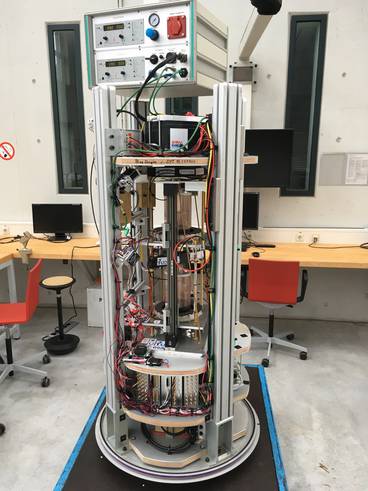Investigation of Ferrofluids Dynamics and Model Validation in Microgravity Conditions (The Ferros)

research area: fluid dynamics
experiment title:
Investigation of Ferrofluids Dynamics and Model Validation in Microgravity Conditions (The Ferros)
experiment acronym: DYT
funding agency:
ESA (Education) / ZARM
grant number:
Drop Your Thesis! - Program
performing organization:
Aerospace Engineering and Fluid Mechanics, University of Seville, Spain / Space Engineering Department, TU Delft, The Netherlands
prime investigator:
Prof. Elena de Castro Hernández / Prof. Angelo Cervone
(Álvaro Romero Calvo, Lidia Parrilla Benítez, Tim H.J. Hermans)
experiment objective
abstract
Ferrofluids are carrier liquids in which magnetic nanoparticles are suspended. The behaviour of ferrofluids in microgravity is largely unexplored because experiments in microgravity are expensive and the access to associated facilities is limited. It would be beneficial for both fundamental research and future applications of ferrofluids in Space to obtain a computational fluid dynamics model of ferrofluids in microgravity conditions. However, experimental data to validate such models is hardly available. Therefore, this experiment aims to quantify the free surface movement of ferrofluids in microgravity under the influence of a magnetic field and certain external oscillation/actuation. The second objective is to compare this experimental data with predictions of a CFD model in order to validate its dynamics.
To accomplish these objectives, an experiment set-up was designed that imposes a well- defined magnetic field on a solution of water-based ferrofluids inside two cylindrical Plexiglass containers. The novelty of the design is reflected in two aspects. First of all, the dynamics of a ferrofluid in microgravity were never studied under the influence of both a constant magnetic field and a percussion mechanism. Secondly, the design is such that it avoids obscuring the video images because of the ferrofluid wetting of the container surfaces, and enables reliable postprocessing, in contrast with preceding experiments.
The experiment will be launched 5 times in the ZARM Drop Tower in Bremen. In order to obtain a wide range of testing conditions. During the post-processing of the video data, a 3D representation of the ferrofluid free-surface surface will be constructed and relevant dynamical parameters will be extracted. We plan to publish our results (experimental data and related conclusions drawn) to the academic society via papers and conferences, but are also actively involving the general public through public outreach activities.
related publications
- Investigation of Ferrofluids Dynamics and Model Validation in Microgravity Conditions (The Ferros), Drop Your Thesis! 2017 - Final Report. ESA Human Spaceflight and Exploration, Erasmus Experiment Archive
experiment campaigns
experiment year: 2017
number of drops: 5


 "
"